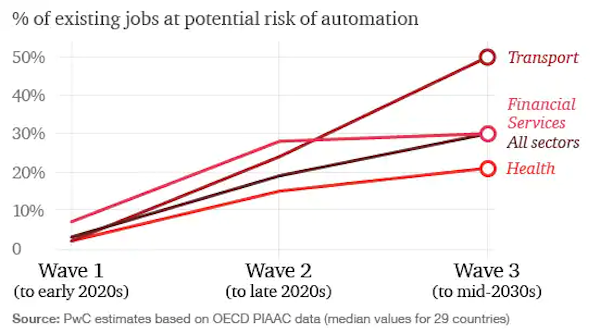
06/11/2019
There has been a lot of tech news coming out of Amazon’s inaugural re:MARS event in Las Vegas last week, some already noted here (Jeff Bezos Predicts Advanced Robot Hands in a Decade).
Below, billionaire Amazon owner Jeff Bezos chats up technology at his re:MARS conference.

Many reports from attendees centered around all the sparkly new automation and A.I. advances, so it was a relief to find one that addressed the coming threat to human employment from smart machines. Author Kyle Wiggers (linked below) even included a list of dire predictions near the end of his article, somewhat similar to my collection in the following paragraph:
Oxford researchers forecast in 2013 that nearly half of American jobs were vulnerable to machine or software replacement within 20 years. Rice University computer scientist Moshe Vardi believes that in 30 years humans will become largely obsolete, and world joblessness will reach 50 percent. The Gartner tech advising company believes that one-third of jobs will be done by machines by 2025. The consultancy firm PwC published a report last year that forecast robots could take 38 percent of US jobs by 2030. In November 2017, the McKinsey Global Institute reported that automation “could displace up to 800 million workers — 30 percent of the global workforce — by 2030.” Forrester Research estimates that robots and artificial intelligence could eliminate nearly 25 million jobs in the United States over the next decade, but it should create nearly 15 million positions, resulting in a loss of 10 million US jobs. Kai-Fu Lee, the venture capitalist and author of AI Superpowers: China, Silicon Valley, and the New World Order, forecast on CBS’ Sixty Minutes about automation and artificial intelligence: “in 15 years, that’s going to displace about 40 percent of the jobs in the world.” A February 2018 paper from Bain & Company, Labor 2030, predicted, “By the end of the 2020s, automation may eliminate 20% to 25% of current jobs.”
The point is that the automated future is bearing down on us with little attention from our political leaders — what’s to be done when significant numbers of American workers become unemployed because of robots, automation and artificial intelligence?
For one thing, it makes no sense to admit a million Central American peasants (plus increasing numbers of African aliens) when the jobs they are capable of performing will soon be done more cheaply by machines.
Some tech experts estimate that serious automation is only a few years off, as indicated by the chart below from a 2017 PwC report, How will automation impact jobs?

As we see from the re:MARS event, the tech community is industrious, goal-oriented and cares little about upending the existing economic order of wages for human work that has sustained our civilization for millennia.
AI Weekly: Amazon’s robots could cut delivery times, but eliminate jobs, By Kyle Wiggers, VentureBeat.com, June 7, 2019
Today marked the end of Amazon’s inaugural re:MARS event in Las Vegas, where roughly 3,000 engineers, academics, programmers, astronauts, artists, entrepreneurs, and NBA players from over 40 countries gathered to glean insight from luminaries in machine learning, artificial intelligence, robotics, and space travel. It didn’t disappoint with respect to sheer breadth of content: Roughly 100 breakout presentations, workshops, and a technical showcase doomed this writer’s mission to cover everything on hand.
Robert Downey Jr., channeling his inner Iron Man, on Wednesday announced the Footprint Coalition, which seeks to significantly “clean up” the planet within the next 11 years. Rohit Prasad, Amazon VP and head scientist for Alexa, introduced Conversations, a deep learning-based way to create Alexa skills with multi-turn dialogue that can interconnect with other Alexa skills. Zoox CEO Aicha Evans detailed the hardware and software underpinning the company’s custom-designed and shuttle-like driverless vehicles. And that was just the tip of an enormous iceberg.
But what stood out most were perhaps the advancements in robotics and what they could mean for the workforce of the future.
During the first re:MARS keynote, Brad Porter, head of robotics at Amazon, unveiled two platforms bound for Amazon’s hundreds of fulfillment centers around the world. The first is Pegasus, an item-categorizing system that cuts down missorted goods by 50%. The other is Xanthus, a modular drive system that quickly adapts to new applications. Both make up a portion of the over 200,000 machines that now work alongside the 300,000 human workers in Amazon’s warehouses — up from 100,000 machines a year ago.
“Customer expectations for convenience, selection, costs, and especially delivery speed continue to increase, and we realize we need step function changes in robotics,” said Porter.
During that same keynote address, Amazon worldwide consumer CEO Jeff Wilke revealed a new six-propeller, electric, and fully autonomous Prime Air delivery drone that will soon begin delivering packages to customers as part of pilot tests. Amazon is aiming to fulfill deliveries of packages weighing up to five pounds within 30 minutes for shoppers who are within 7.5 miles (up to a maximum of 15 miles) of its warehouses.
And on the penultimate day of re:MARS, Amazon chief technology officer and vice president Werner Vogels highlighted RoboMaker, the company’s cloud robotics service designed to expedite developing, testing, and deploying intelligent machines at scale. “We’re now getting lots of attention and interest [in this],” said Vogels. “If we do this right, we will see the next generation of explorers working on the next generation of robotics technology.”
Amazon’s increased investment in robotics — which arguably began in earnest with its $775 million acquisition in 2012 of Kiva Systems, a Massachusetts-based company that manufactures mobile robotic fulfillment systems — accelerated with its recent purchase of Canvas Technology. The Colorado-based startup is developing a fully autonomous cart system. Even more recently, in warehouses in Seattle, Frankfurt, Milan, Amsterdam, and Manchester, Amazon has doubled down with $1-million-per-unit machines — CartonWraps and SmartPacs — capable of packing up to 700 products in an hour.
The moves are doubtless reducing operations costs — the savings with CartonWraps and SmartPacs are so substantial that each robot is amortized in less than two years. And they will likely further Amazon’s ambitious plan to reduce its free shipping option for all Prime subscribers from two days down to one.
But it’s a less encouraging development for the human workers whose jobs are at risk due to partial or complete automation.
A 2017 analysis published by Quartz found that Amazon’s investment in automation and robotic employees will cause the combined employment at the company and related retailers to decline by a net 24,000 in 2018. Separately, Forrester found that AI could eliminate 10% of U.S. jobs in the coming months, and in the past year, analysts at the World Economic Forum, PricewaterhouseCoopers, McKinsey Global Institute, and Gartner have predicted it could make redundant as many as 75 million jobs by 2025. (Continues)
This is a content archive of VDARE.com, which Letitia James forced off of the Internet using lawfare.